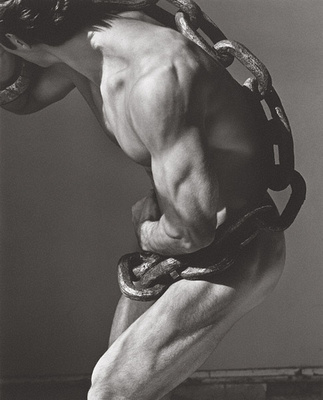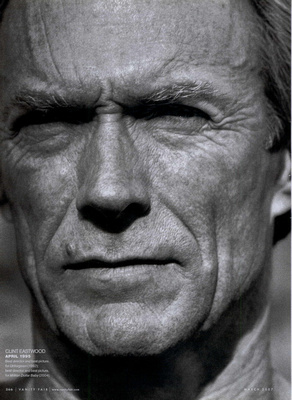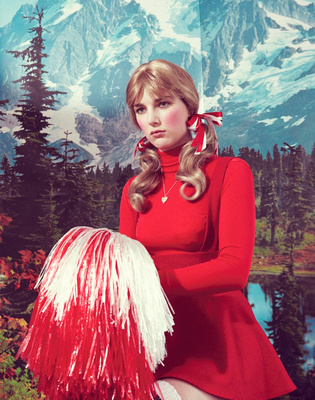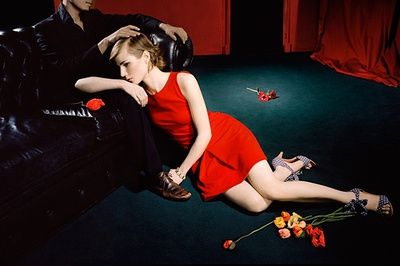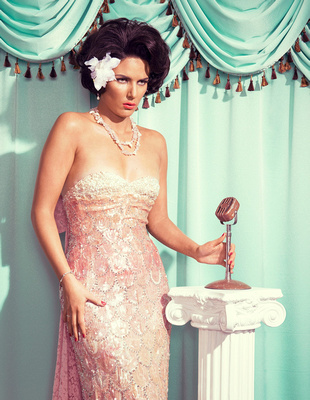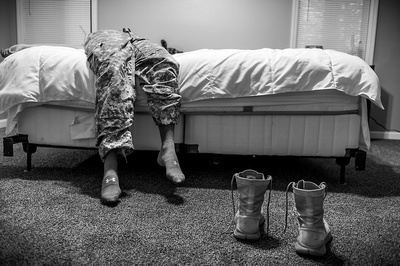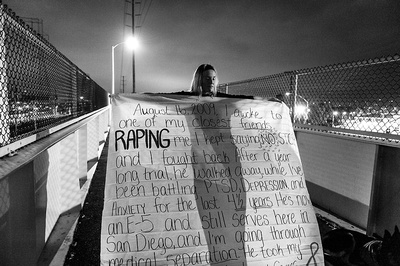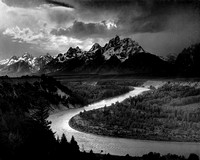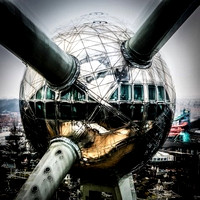Revealed: Herb RittsHerb Ritts was one of the most renowned fashion/portrait photographers of the 80s and 90s. In areas of photography where it is too easy to be formulaic and bland, his work always stood out. Here are a few suggestions as to why.
Yet this never leads to boring shots in Ritts' case. Working within the constraints of a restrained and classy style never stopped him from creating powerful, enticing, beautiful, and sometimes humorous pictures. Quite the opposite, he often managed to subtly highlight interesting things about his subjects in ways a more aggressive style would not allow. Not only does this reaffirm how photography can act as a revelator, but this illustrates how self-imposed constraints can spur creativity and generate a unique view of the world. All the while retaining an extremely appealing beauty. One of the sources of this beauty probably lies in Ritts' knowledge and use of classical - and I'm really talking about greco-roman art here - visual language. In many of Ritts' works one will find postures and attitudes reminiscent of greek gods and godesses. His subjects come forward as larger than life heroes radiating their glory. Yet his unique take and composition skills lend a definite modern flavour to his pictures.
These subtle mixes make Ritts' photography unique, revealing a unique worldview - mixing tradition and modernity - on his part as well as highlighting crucial aspects of his subjects. Yet another great photographer who spent his career in aletheia - revelation.
Revealing: Kourtney RoyKourtney Roy is a canadian photographer living in Paris whose work is intriguing, witty, elegant and smart. Hers is also a body of work that grows on you. Apart from her fine-art photography, Roy also does fashion photography, and it shows. Hers is a refined world, with stunning wardrobes, glorious lighting, and elaborate poses. She works in color, and her colors are exquisite - more about them later. Yet while the high fashion interest shows, it doesn't dominate her work, it informs it if you will. Yes there is glamour in her shots, but it is far from the only component.
While Roy's style is what first attracts the eye and makes one want to explore her works - and keeps providing long lasting enjoyment - her subjects are highly intriguing. At first glance, the vignettes she carefully poses seem typical to the decades after which the pictures are styled. They figure different women of different styles - though mostly in one form of glamour or another. But close inspection reveals that these different women are (nearly) all Roy herself, assuming different styles in such a complete
In a way, it seems that Roy's stance could be considered a post-feminist one. By becoming the "objectificator" - of herself to boot - she makes the compositions more acceptable. She seems to say "It's ok when freely done by willing and conscious participants" - a notion that could be linked to sex-positive feminism. But despite whoever stands behind the camera, the viewer is reminded of the fine line between innocent play and aesthetic construction on one hand, and degrading objectification on the other. This constant interplay, added to the frequently undecipherable attitude she has on her pictures - mixing boredom, sadness, mischief and many more - means the viewer is perpetually creating his own understanding of what is going on in the picture. As such, these are pictures one is compelled to come back to, to try and understand the mystery underlying the vignette.
Roy thus composes pictures with intriguing subjects of which more can always be learned by further observation, forcing us as viewers to assess our beliefs and understanding of the vignettes she creates, and reveals herself in her preoccupation and as permanence through the change of characters she assumes. Once again, it is a powerful interplay between what is revealed of the subject, the viewer and the photographer that leads to great photography. Because if much is mysterious about Roy's pictures, one thing is clear as day: her work is always astounding. Revealed: Mary F. CalvertMary F. Calvert is a renowned photojournalist, recipient of the Robert F. Kennedy Journalism award (twice) and the Canon Female Photojournalist award. She doesn't do funny; her work focuses on (quoting her website) "the under-reported humanitarian struggle of women and children worldwide to secure the most basic human rights". We're talking serious stuff. And it's both moving and beautiful. As is stated all over this website, I believe that photography lies at the intersection of the subject, the photographer and the observer, and that it should reveal something about one of the three. Great photography reveals something about all three. By this criterion - as by many others - Calvert's work is obviously great photography.
Calvert's work also tells us about her. To put it very simply, her concerns are fairly obvious from what she chooses as subjects - the plight of others weighs heavily on Calvert's mind. Yet she manages to reveal beauty in otherwise horrendous circumstances, displaying her concern for aesthetics as well as ethics. And then it is striking that some of her strongest pictures are defined by an absence, the subject being guessed at, seen as absence, barely hinted at. This approach, for someone tackling harsh realities, indicates a concern for displaying the horrors of the world with empathy, a care for the individuals, and a strong sense of restraint so as not to invade too strongly on the lives of the people she depicts. In other words, her work reveals Calvert to be a humanist.
I find it interesting that though Calvert provides interesting and enlightening captions to her pictures, they are absolutely not necessary to "understand" and feel them. They stand on their own and call the observer to better understand them. That is the sign of powerful work. For the sake of consistency, all pictures illustrating this post are taken from her series "The Battle Within: Sexual Assault in America's Military Part 2: The Survivors" series, but I urge you to take a look at her other projects as well. Calvert's is beautiful and important work.
Revealed: Ansel AdamsAnsel Adams is one of the undisputed masters of landscape photography. His works are influential to this day, and this post aims at showing why he remains extremely relevant, while amusingly informing discussions that go on in the digital world, despite the fact he passed away in 1984.
Do keep in mind Adams lived from 1902 till 1984, being most active between the 30s and 60s. If at first glance your reaction is along the lines of "ok, this is very traditional work", realize that our notion of what a traditional landscape photography looks like owes an immense lot to Adams' work. From here on, it would be easy to continue lauding his photographs and to simply comment some of his breathtaking works, but it seems more interesting to focus on what makes his black and white photography so interesting, and how that can inform modern debates in photography. In large part, it is the stark contrasts between very dark and very light - and the exquisite use of the range in between - that make his pictures so magnificent and fascinating. How did he achieve this? Obviously, deep knowledge of photography technique lead him to excellent exposure. Proper set-up and use of his camera were critical, as was identifying the right moment and light to take his photographs. But a key element in Adams' work was his darkroom technique. He used dodging and burning extensively and masterfully, and that is very interesting for contemporary discussion of the place of post-processing in digital photography. It has become commonplace to criticize "photoshopping", by which people mean changing a photograph from what was actually taken by the camera, as if photography was all about the capture and ended at the moment the photographer releases the shutter button. It's common to have a non-photographer ask you whether you modified the picture after you took it and seem disappointed when you say you did. Even seasoned photographers are sometimes heard professing that a "good" photographer gets his exposure in camera and doesn't tinker with it afterwards. Remembering that a classic film photographer like Adams worked extensively in the darkroom to lighten and darken specific areas of his photographs to produce the photograph he had visualized in his mind when taking it is thus crucial. What he showed wasn't the "pure" photograph taken by his camera, but a conjunction of what his camera had captured and his work on this material to achieve the picture he initially desired. We are not talking about correcting a mistake here (although that might of course happen too), but about artistic expression and creating the intended work of art. Burning and dodging were very complex and required expertise in the film world : dodging meant physically blocking out an area of the enlarger lens to avoid light hitting the paper, whereas burning required masking out all the picture except for the area to be burned to increase the light on the paper. On the other hand, in the digital world a few clicks are enough to dodge and burn. But these differences are irrelevant. Work done in Photoshop, Lightroom, or any other comparable software package aims at the exact same thing as Adams' complex darkroom work: obtaining the desired tones, irrespective of what "came out of the camera". In other words, photography is all about the relationship between the subject, the photographer and the viewer. The camera and whatever other tools might be involved are only there to facilitate this triangular relationship. That might be one of the most important lessons Adams provided us; the aim of photography is that the final work looks the way you intended it to. All the rest - and singularly how you obtained your end result - is a means to an end, and utterly unimportant. While techniques might be interesting to practitioners, they are totally irrelevant when evaluating the artistic merit of the works. So the next time somebody starts telling you that so and so's work is "too processed", remember Ansel Adams and ask the only question that matters: "ok, but does it have artistic merit in your eyes?". Revealing : Laurent DequickAs those who read the about page know, Aletheia is about attempting to reveal... stuff. Largely through my own photography. But it seems only fitting to also shine the spotlight on other photographers whom I find interesting.
My first pick is nearly a lazy one. Laurent Dequick is thankfully gaining a healthy reputation and growing into the highly successful photographer he deserves to be. People who are kind enough to consider my little website are likely to have seen or heard of Laurent's work. But then again maybe not, and in any case, he deserves any additional praise he can get.
Laurent's work is unique and inspiring. Most of it revolves around multiple exposures of urban landscapes melded into one striking photograph. But if you are thinking about HDR, think again, the aim is quite different. We're not talking about superimposing identical shots with different exposure levels to increase dynamic range here, but of mixing up the exposures in a "misaligned" fashion if you will. This creates a totally new image, the effect of which has sometimes been described as "vibratory" - see the "vibrating" Atomium picture here - and Laurent himself named one of his series "Vibrations urbaines" to reflect this. It's really a very personal style and one you have to see to appreciate fully.
There are many reasons I am in love with Laurent's work.
First, it just looks stunning. On a purely aesthetic level it's wonderful, a very beautiful body of work that holds me in awe. That alone would make it worthwhile.
But it goes further. Laurent started out as an architect before being a photographer, and it shows. A deep understanding and love of the urban landscapes he depicts permeates Laurent's work. I love cities and urban landscapes too, and here is a photographer that depicts cities in a beautiful, glorious way. His unique technique underlines their liveliness. It's a breath of fresh air to have this playful representation of cities, when so much photography tends to focus on the darker or grittier aspects.
In typical "aletheia-revelatory" fashion, Laurent is basically revealing the intrinsic beauty of subjects some might take for granted or even find ugly at first glance. I have a deep appreciation for any work that can reveal non-obvious beauty, and Laurent's definitely fits that bill. Because while many will acknowledge the beauty of Venice or Barcelona, two of his subjects, it will come as a surprise to some to be so delighted by the beauty of Hong Kong or even some unorthodox views of London or Antwerp.
Laurent's work also basically fingers its nose at the notion that only photography adhering to a strict set of rules is worthwhile. For starters, it ridicules those people who would reject digital post-processing as unworthy of photography. Laurent's way of working is obviously post-processing heavy, without this being detrimental to the art, quite to the contrary. Interestingly enough, it seems to me that like most good post-processing, it actually tells us more about the actual subject than a "neutral" treatment would have. Furthermore, it can sometimes be argued that Laurent plays with, and occasionally discards, typical rules of composition, here again to great effect. Of course, deep mastery of traditional photography rules is evident in his work, but this mastery allows him to bypass them efficiently when it serves his purpose.
Finally, it should be noted that he is an extremely friendly and interesting individual. When I met him at an opening, I had the chance to chat and laugh with an agreeable, smart, witty and humble fellow. This changes nothing about his art, but makes it all the more pleasant to recommend him. Please do check out his work if you don't know it, and consider buying his still quite affordable art - it won't remain that affordable for long. |



